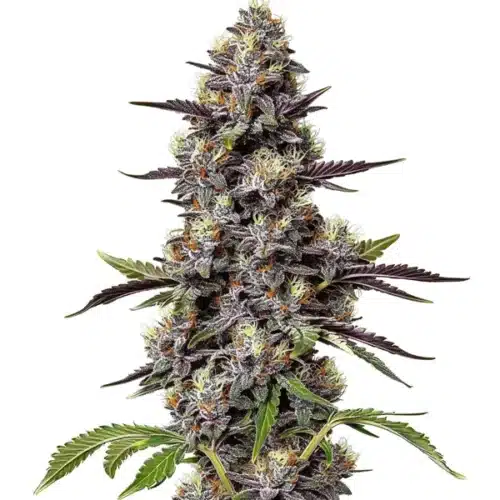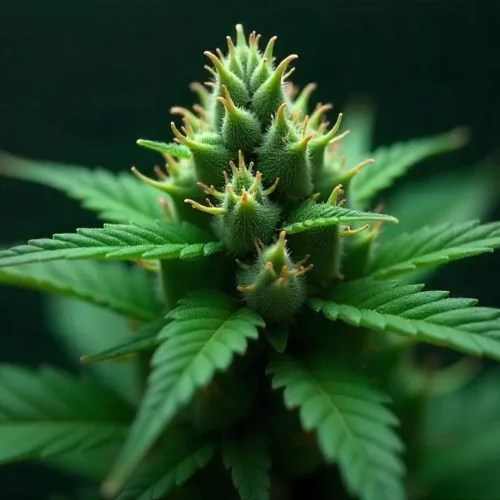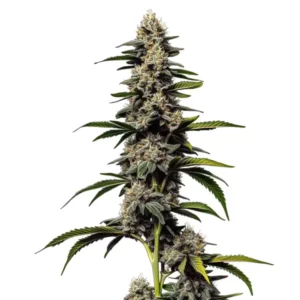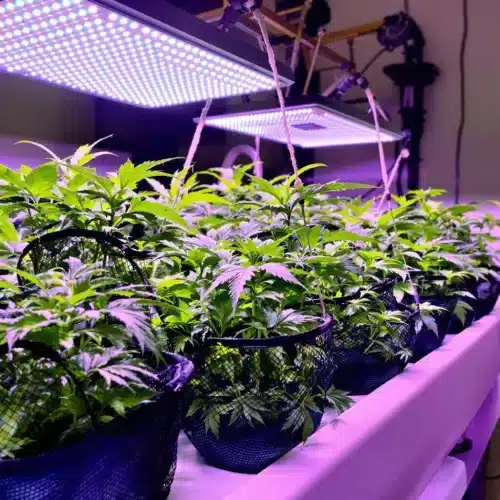Many growers have problems with the cultivation of their marijuana plants because they tend to spike which means that at the time of growth, the plants do not develop correctly and, ultimately, during flowering, their specimens do not produce the harvests that were expected. For these reasons, in this guide, we are going to give you some tips so that you can obtain the best harvests by controlling the height of the plants, both indoors and outdoors.
Prune to control height
Marijuana pruning is an ideal technique to control the height and shape our plants. There are different types of pruning and not all have the same purpose, so we are going to explain each one of them. Pruning is an ideal technique for small, low-rise spaces and for crops on terraces or balconies. By performing various prunings during growth, we activate lateral growth, preventing the plant from growing out of control. They will always be done during the vegetative stage and at the latest, at the beginning of the pre-flowering phase. However, we will never do pruning during the flowering phase as it will only cause stress, delaying the flowering of the plants.
Recommended Strains
Critical Purple Kush
 THC: 16 - 18%
THC: 16 - 18% Type of seed: Feminized
Type of seed: Feminized Phenotype: Mostly Indica
Phenotype: Mostly Indica Day to flower: 7 - 9 weeks
Day to flower: 7 - 9 weeks
Northern Lights x Chronic
 THC: 15% - 19%
THC: 15% - 19% Type of seed: Feminized
Type of seed: Feminized Phenotype: Mostly Indica
Phenotype: Mostly Indica Day to flower: 7 - 8 weeks
Day to flower: 7 - 8 weeks
Promos & Deals
Lollypop Pruning or Bass Pruning:
Lollypop pruning is the simplest of all: we only have to remove the lower branches in the cleanest way possible. We don’t lose much because those branches are usually very unproductive, giving small and low quality buds. Thanks to this technique, we improve the aeration of the lower part of the crop, preventing the appearance of any type of fungus. When we remove the lower branches, it will be much easier to water our plants. In addition, by not devoting effort to these lower branches, the plant dedicates all its energy to the upper part, achieving bigger and harder buds.

Topping
Topping is one of the most used techniques among growers. Any pruning can be used in both outdoor and indoor crops. To carry out this pruning, we wait for the plant to have 4 or 5 nodes. The cut will be made above the penultimate node of the upper part. After a few days, the shoots will begin to grow in a “Y” shape, becoming two points instead of one. This technique can be repeated as many times as desired, letting the plant rest between prunings.
Fim Pruning
FIM pruning was discovered through the mistake of a grower who wanted to apply a topping. Instead, he cut into the bud itself, leaving 20-25% of it. The difference between topping and FIM, apart from the cut area, is that FIM will cause the development of 4 new shoots. This technique does not always go well, but if it does, it is very practical. Do not be discouraged if this technique does not work for you the first time. Little by little, you will pick up the pace and improve in cultivation.
RIB Pruning
This pruning is very special because it is done during the flowering phase. The important thing in this phase is that you do not have to take energy away from the plant. Therefore, we do not recommend carrying out this pruning without first mastering all of the others.
This pruning consists of making a small superficial cut of the pistils or burning them with the help of a lighter. I know it seems somewhat violent… that’s why it’s not widely used within the sector. Sometimes, when we have the focus too close to the plants, the pistils crack and we carry out this pruning without knowing it. It is usually done in the middle of flowering, giving the plant time to recover from stress and start the process of regeneration of the flower.
The right lighting system
Plants naturally grow looking for the light source that illuminates them. In low light situations, they will glean for that source, resulting in weak plants with long stems and sparse foliage. We can avoid this phenomenon if we follow two simple steps. The first is not to put too many plants in our cultivation. It is always tempting to take advantage of the space left between the pots or in the corners of the indoor grow. However, too high of a population of plants will only result in a lower use of light by each of them and they will grow competing for light.
The second step to avoiding bolting is, of course, to use grow lights of the correct wattage and placed at the correct distance from the plants. This depends on the type and power of light that we use as well as the variety. Each plant supports factors such as light exposure and temperature in a different way. CMH LEC fixtures are excellent options to avoid stretch in addition to producing more grams per watt than conventional HPS bulbs.
In relation to lighting, the light spectrum of the light systems used is also relevant because it is common practice among indoor growers to use sodium lamps (HPS) throughout flowering. These lighting systems produce a warm spectrum of light with a higher frequency of reds, designed to mimic autumn sunlight. However, it is precisely this red spectrum that causes plants to sprout more than lamps with a colder spectrum (blue) such as Metal Halide or LEC lighting kits.
Indeed, these lights which are usually used for the growth phase promote a shorter internodal distance, so we can also use them during the pre-flowering stage (after the change to 12/12) to limit bolting and maintain the plants at a reasonable height. After 2-3 weeks with the flowering photoperiod when the spiking of the plants begins to slow down, we can replace our Halide lights with the classic Sodium ones. Also, we can use state-of-the-art LED lighting that has a very large spectrum of light and even tends to work better than the classic HPS lights during the growth phase and in flowering.
Temperature and Air in the crop
The temperature of the room is important. If it is too warm, the plants will stretch. But it is not as simple as that because the difference between daytime and nighttime temperatures is also a factor to take into account. The wider the difference in temperature, the greater the distance between floral internodes (the length of stem between buds). In an ideal world, you should aim for the difference between day and night temperatures to be about 4 degrees Celsius. If you can achieve 22ºC during the day and 18ºC at night, the plants will perform at their best. Temperature is especially important for the plant in weeks 2 and 3 of flowering when they are finishing their stretching phase. I have heard of some growers achieving extremely short internodes by reversing the temperature differential so that the plants are warmer at night. Don’t get complicated, a difference of 5ºC is enough.
Air movement around plants is hugely important for many reasons. It also helps keep height in check. During growth, the air circulation must be fast enough to move the plants. Because the seed germinates or the cutting has rooted and can withstand the breeze without wilting, it is recommended to place it so that it receives air from an oscillating fan. This strengthens the stem and encourages lateral versus vertical growth, almost as if the plant knows the wind will knock it over if it grows too tall. Nature is a very intelligent cultivator. Once the climate has been adjusted, let’s look at other more creative ways to control the height of the plants.
SCROG
The SOG technique is about installing a mesh several centimeters above the plants so that when a point goes through the mesh, it bends back down and grows horizontally. The growth tip will immediately reposition itself and go back through the mesh vertically and the grower will push it back down. When the stretching that occurs during the first two or three weeks of flowering is over, it is best to let the buds grow vertically through the mesh. At this time, the plant will already be short and wide, so the light will penetrate in an excellent way in the canopy.
After trying many different types of mesh, the best material is the plastic mesh used to make fences which comes in rolls with 2-inch square holes. It’s ideal because it’s flexible, but at the same time it is strong enough to hold its shape. It cuts easily with scissors, so if you haven’t checked the crop for a few days and find a branch growing through the wrong hole, you can cut the mesh and reposition the branch which is not so easy to do with a mesh wire.
If you are managing plants with a combination of LST and topping in the vegetative phase, you can easily continue with a SCROG system during flowering. We recommended the FIM technique as soon as possible (from the third internode on a plant from seed or equivalent on cuttings). It is then allowed to grow vertically for a week and the LST system is started to encourage bushy growth. It may be interesting to use the FIM technique again on the tips once the plant has become wider to maximize the potential number of tips. Ideally, you want a flat canopy at the end of the vegetative phase that is ready for an explosive bloom.
Select the right strain
This is the most important factor to consider when trying to avoid spindly plants or controlling plant height. It is important to ensure that the variety we choose to grow, whether from seed or clone, will adapt to our growing space. This is also true if we want to grow different varieties in the same space. We must always choose those that have similar characteristics, both in pattern of growth and flowering as well as in the duration of the latter. This way, we will achieve a crop that is as homogeneous as possible, making the most of our grow lamp.
Generally, varieties with an Indica tendency or mostly Indica do not suffer from a spike as pronounced as sativa genetics, although there are exceptions because many times, the phenotypes of the plants are expressed in a different way than one tends to think. There are even indica varieties which can shed considerably during the first 2-3 weeks of flowering, making it necessary to use meshes or stakes to support the branches.
Critical Purple Kush
Critical Purple Kush is a mostly Indica variety of medium size that can grow very large if some pruning is applied. It delivers yields of 500 – 600 gr/m2 if you grow it indoors. In addition, it is outdoors where you can get the best reward with harvests, ranging from 600 – 700 gr/plant. The flowering of this strain is short and only takes about 8 weeks to produce buds that give off sweet flavors with intense notes of coffee and an earthy aftertaste.
Now, the punch of Critical Purple Kush is intense and relaxing due to its genetics which are a cross between Critical x Purple OG. This strain manages to produce THC levels that range from 16%-18%. It is also recommended to use ties for the lateral branches and the central stem on this plant, therefore an LST is perfect for it.
Northern Lights x Chronic
Northern Lights x Chronic is a cross of two legendary mostly Indica varieties. Its short internodes give it a compact, bushy shape with thick arms that support the weight of the flowering buds. Despite being medium or short in size, it can shed a bit in the last part of growth and beginning of flowering. For the same reason, we recommend that you grow it in a SOG system or with SCROG meshes, trying to stretch its arms so that the light filters among the dense buds.
Also noteworthy are the buds that are covered in resin and have THC levels that are between 15% – 19%. It produces relaxing effects, especially for people who suffer from insomnia, stress, or chronic pain. On the other hand, the flavors of this herb are a mixture between wood and lemon and a refreshing touch to the palate is felt in each smoke in a unique way.
Green Crack Auto
We cannot fail to mention at least one autoflowering variety for lovers of automatic genetics. We present Green Crack Auto, a strain that is characterized by having a compact size and being easy to grow both indoors and outdoors. This variety produces between 500 – 600 gr/m2 in indoor crops. For outdoor gardeners, this strain prepares about 200 – 300 gr/plant of buds that have fruity, mango flavors.
The punch is euphoric at the beginning and ends with a good relaxation thanks to its levels of THC which are between 18% – 20%. You can enjoy this strain after 7 – 8 weeks of cultivation. As you can see, it is a fast genetic that gives you the chance to grow it easily with minimal requirements, intended for novice growers.


















